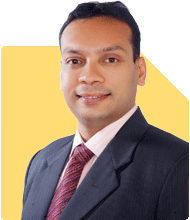Ramalingam Kalirajan |6504 Answers |Ask -Follow
Mutual Funds, Financial Planning Expert - Answered on Jul 06, 2024
He has an MBA in finance from the University of Madras and is a certified financial planner.
He is the director and chief financial planner at Holistic Investment, a Chennai-based firm that offers financial planning and wealth management advice.... more

Hi, we are a 36 year old couple witha 1 yr old kid and financially dependent parents from both sides. We have a combined income of 3.5L from which we invest 25k in Mutual funds & 10k in ppf each month. Medical insurance is provided by our comapnies for the family worth 10 L. We also have a loan worth 7 L and 8 months living expesne lying in liquid savings. Please give a break up of financial plan for saving 2 cr corpus for our retirement and 1cr for child education.
Understanding Your Current Financial Position
First off, kudos to you for being proactive about your finances! You have a Rs 7 lakh loan and 8 months’ living expenses in liquid savings. Your monthly investments of Rs 25,000 in mutual funds and Rs 10,000 in PPF are a great start. The medical insurance worth Rs 10 lakh provided by your companies is also a valuable safety net.
Setting Clear Financial Goals
You have two primary financial goals:
Accumulating Rs 2 crore for retirement.
Accumulating Rs 1 crore for your child’s education.
These goals are achievable with a well-structured financial plan. Let's break down the steps to reach them.
Building a Strong Financial Foundation
Before diving into investments, it's crucial to ensure a strong financial foundation. Here’s how:
Emergency Fund
You already have 8 months’ living expenses in liquid savings, which is excellent. This fund should cover at least 6-12 months of expenses, so you’re well-prepared for any unexpected financial challenges.
Loan Repayment
Consider allocating a portion of your income towards paying off your Rs 7 lakh loan. Reducing debt early can save you significant interest over time and free up more funds for investment.
Strategic Investment Planning
Now, let's create a plan to achieve your goals through strategic investments.
Monthly Investment Allocation
You’re currently investing Rs 35,000 per month (Rs 25,000 in mutual funds and Rs 10,000 in PPF). Given your goals, it’s crucial to optimize these investments.
Mutual Fund Investments
Mutual funds are a powerful tool for building wealth over time. Here’s a breakdown of different categories and their benefits:
Equity Mutual Funds: These funds invest in stocks and have high growth potential. They’re ideal for long-term goals like retirement and child education. Various types include:
Large-Cap Funds: Invest in well-established companies. They provide stable returns with moderate risk.
Mid-Cap Funds: Invest in mid-sized companies. They offer higher growth potential but come with higher risk.
Small-Cap Funds: Invest in smaller companies. They have the highest growth potential but also the highest risk.
Debt Mutual Funds: These funds invest in fixed-income securities like bonds. They provide stable returns and are less risky. Suitable for short to medium-term goals.
Hybrid Funds: These funds invest in a mix of equity and debt, offering a balanced approach. They provide moderate returns with reduced risk, making them ideal for medium-term goals.
Benefits of Actively Managed Funds
Actively managed funds have the advantage of professional management. Fund managers make strategic investment decisions to outperform the market, which can be particularly beneficial in the Indian market where active management can exploit market inefficiencies for better returns.
Systematic Investment Plans (SIPs)
SIPs are an excellent way to invest regularly. They help average out the purchase cost and reduce the impact of market volatility. Here’s a suggested SIP allocation:
Equity Mutual Funds: Allocate a significant portion here for long-term growth. Consider a mix of large-cap, mid-cap, and small-cap funds.
Debt Mutual Funds: Allocate a smaller portion here for stability and to cover short to medium-term goals.
Hybrid Funds: Use these for a balanced approach, combining growth and stability.
Power of Compounding
The power of compounding is a crucial element in wealth building. The earlier you start investing and the longer you stay invested, the more your money grows. Reinvesting your earnings allows your investments to grow exponentially over time.
Detailed Investment Strategy
Here’s a detailed investment strategy to achieve your goals:
For Retirement (Rs 2 Crore in 24 Years)
Given you’re 36 now, you have 24 years until retirement. Here’s how to allocate your investments:
Equity Mutual Funds: Allocate a significant portion of your monthly investment to large-cap, mid-cap, and small-cap funds. This will provide high growth potential over the long term.
PPF: Continue your Rs 10,000 monthly investment in PPF. It offers stable, tax-free returns and is a great addition to your retirement corpus.
Debt Mutual Funds: Allocate a smaller portion here for stability. These funds provide consistent returns with lower risk, balancing your portfolio.
For Child Education (Rs 1 Crore in 17 Years)
You have 17 years until your child starts higher education. Here’s the allocation strategy:
Equity Mutual Funds: Similar to retirement, allocate a significant portion to large-cap, mid-cap, and small-cap funds. The long-term growth potential will help build a substantial corpus.
Debt Mutual Funds: Allocate a portion here for stability. These funds provide consistent returns, ensuring a balanced approach.
Child-Specific Mutual Funds: Consider child-specific mutual funds that are designed to meet education expenses. They offer tax benefits and are tailored to long-term goals.
Risk Management
Managing risk is crucial in any investment plan. Here’s how to do it:
Diversification: Spread your investments across different asset classes and sectors. This reduces the impact of any single investment’s poor performance.
Regular Reviews: Keep track of your investments and make necessary adjustments based on performance and changing market conditions.
Staggered Investments: Instead of lump sum investments, stagger them to benefit from market fluctuations. This reduces the risk of timing the market.
Insurance Coverage
While your companies provide medical insurance worth Rs 10 lakh, consider additional health insurance if needed. Also, ensure you have adequate life insurance coverage to protect your family financially in case of unforeseen events. Term insurance offers high coverage at low premiums, which is ideal.
Avoiding High-Cost Investment Products
Stay clear of investment products with high charges like ULIPs or investment-cum-insurance products. They often underperform due to high costs. Instead, invest in pure insurance products and mutual funds separately.
Final Insights
Creating a solid financial plan requires a disciplined approach and strategic investments. Start by building a strong financial foundation with an emergency fund and debt repayment. Optimize your investments through SIPs in equity, debt, and hybrid mutual funds. Diversify your portfolio to manage risks and ensure consistent returns.
Achieving Rs 2 crore for retirement and Rs 1 crore for your child’s education is challenging but feasible. Stick to your plan, regularly review your investments, and make adjustments as needed. With patience and discipline, you’ll be well on your way to achieving your financial goals.
Best Regards,
K. Ramalingam, MBA, CFP,
Chief Financial Planner,
www.holisticinvestment.in
You may like to see similar questions and answers below
Ramalingam Kalirajan |6504 Answers |Ask -Follow
Mutual Funds, Financial Planning Expert - Answered on Jun 18, 2024
Ramalingam Kalirajan |6504 Answers |Ask -Follow
Mutual Funds, Financial Planning Expert - Answered on Jul 04, 2024
Ramalingam Kalirajan |6504 Answers |Ask -Follow
Mutual Funds, Financial Planning Expert - Answered on Jul 25, 2024
Ramalingam Kalirajan |6504 Answers |Ask -Follow
Mutual Funds, Financial Planning Expert - Answered on Oct 05, 2024
Dr Dipankar Dutta |653 Answers |Ask -Follow
Tech Careers and Skill Development Expert - Answered on Oct 04, 2024
Krishna Kumar |377 Answers |Ask -Follow
Workplace Expert - Answered on Oct 04, 2024
Krishna Kumar |377 Answers |Ask -Follow
Workplace Expert - Answered on Oct 04, 2024
Krishna Kumar |377 Answers |Ask -Follow
Workplace Expert - Answered on Oct 04, 2024
Krishna Kumar |377 Answers |Ask -Follow
Workplace Expert - Answered on Oct 04, 2024
Krishna Kumar |377 Answers |Ask -Follow
Workplace Expert - Answered on Oct 04, 2024
Krishna Kumar |377 Answers |Ask -Follow
Workplace Expert - Answered on Oct 04, 2024
Krishna Kumar |377 Answers |Ask -Follow
Workplace Expert - Answered on Oct 04, 2024
Krishna Kumar |377 Answers |Ask -Follow
Workplace Expert - Answered on Oct 04, 2024























